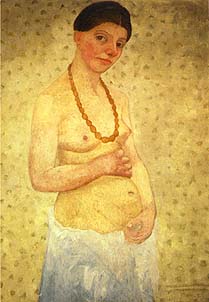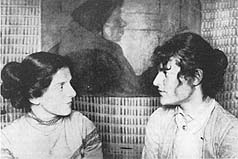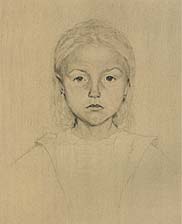Paula Modersohn-Becker's modernity by Nelly Gabriel The Museum of Printing displays the engraved and drawn works of the artists from Worpswede. This is an occasion for the inhabitants of Lyon to discover this active
German community at the turning-point of the century. And in particular Paula Modersohn-Becker.
Paula Becker's fate is a tragical one. She
died 31, just after reaching her top. But a feast is not necessarily better just because it is longer. And this woman, who had felt she would die young, lived her life in feast. A
short and intense feast, she told her diary on July 26, 1900. Paula Becker comes to Worpswede in 1898. She is a twenty-five year-old painter, and joins a group of artists who have been living there since 1884.
Searching for a new vision of landscape painting based upon the predominance of the human and the authentic nature, those painters had found in this village and its
vicinity, about twenty kilometers from Brême, a simple and essential surroundings, which was the ultimate goal of their quest.  Fritz Mackensen, the first to come, attracts two of his friends, Otto Moderssohn and Hans am Ende, with
his boundless enthusiasm. After spending a few weeks in Worpswede, they decide to stay, definitely. Two other artists come during the summers of 1893 and 1894: Fritz Overbeck and Heinrich Vogeler. A small community is
organised, grown richer in new members. Among them is Paula Becker.
She is not very interested in landscape and post-romanticism that make her new
friends'success. She shows a lot more interest for the simplicity and the rough presence of the people of Worpswede. It can be easily seen in the drawings and
engravings displayed. She keeps the same attitude, whether she looks at herself or at her friends. The same search for a robust and synthetical shape, a shape
with, sometimes, an audaciously reducer schematical. Very soon, in spite of her technical apprenticeship with Mackensen, she becomes aware of the artistic
limits of her thebaïde. Her influences are wider than Barbizon painters who remain her friends'tutelary inspiration, except Vogeler, who works with talent
into the spirit of Jugenstil, the artistic trend of the time, which made academism out of fashion and tried to make art become part of life. Portfolios' etchings show
with elegance and grace the aesthetics of this trend. We are in a world close to Beardsley, Toorop… Paula Becker wants to go further than this new ornamental
style that spreads over Europe. She looks for a new vision of reality, with its inner structure and not just the outer shape. Without even knowing it, she works
the same way Nabis, Gauguin, or Van Gogh do; or Cézanne, who would upset her when she would discover his work in Paris.  Several times she leaves Worpswede and comes to Paris, improving in her art. In September 1899,
she wrote to her sister: "I think my goals and yours will be more and more different. You will less and less approve me. Nevertheless, I must go on, even if I feel like scaring everybody. I cannot
go back. Just like you, I am going straight ahead, but in my mind and my skin, sticking to my feelings. On December 31, she went to Paris. On the way to modernity.
In 1904, she finds the language she was looking
for; the language of modern art she still makes felt during her last stay in Paris in 1906. Then, two years of an intense creation, and her death, on November 20.1907, just two weeks after the
birth of her daughter, Mathilde, in Worpswede. Museum of Printing (Mo Cordeliers)
-Until December 31/Tel: 04 78 37 65 98
Translated by Michael Berardan |